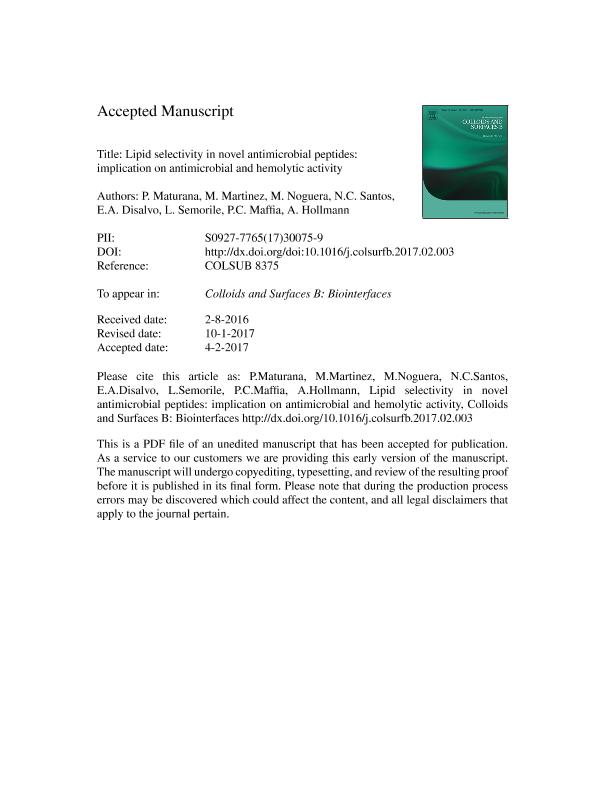Artículo
Lipid selectivity in novel antimicrobial peptides: Implication on antimicrobial and hemolytic activity
Maturana, Patricia del Valle ; Martínez, Melina María Belén
; Martínez, Melina María Belén ; Noguera, Martín Ezequiel
; Noguera, Martín Ezequiel ; Santos, Noelia Encarnacion del Carmen; Disalvo, Edgardo Anibal
; Santos, Noelia Encarnacion del Carmen; Disalvo, Edgardo Anibal ; Semorile, Liliana Carmen; Maffia, Paulo Cesar
; Semorile, Liliana Carmen; Maffia, Paulo Cesar ; Hollmann, Axel
; Hollmann, Axel
 ; Martínez, Melina María Belén
; Martínez, Melina María Belén ; Noguera, Martín Ezequiel
; Noguera, Martín Ezequiel ; Santos, Noelia Encarnacion del Carmen; Disalvo, Edgardo Anibal
; Santos, Noelia Encarnacion del Carmen; Disalvo, Edgardo Anibal ; Semorile, Liliana Carmen; Maffia, Paulo Cesar
; Semorile, Liliana Carmen; Maffia, Paulo Cesar ; Hollmann, Axel
; Hollmann, Axel
Fecha de publicación:
05/2017
Editorial:
Elsevier Science
Revista:
Colloids and Surfaces B: Biointerfaces
ISSN:
0927-7765
Idioma:
Inglés
Tipo de recurso:
Artículo publicado
Clasificación temática:
Resumen
Antimicrobial peptides (AMPs) are small cationic molecules that display antimicrobial activity against a wide range of bacteria, fungi and viruses. For an AMP to be considered as a therapeutic option, it must have not only potent antibacterial properties but also low hemolytic and cytotoxic activities [1]. Even though many studies have been conducted in order to correlate the antimicrobial activity with affinity toward model lipid membranes, the use of these membranes to explain cytotoxic effects (especially hemolysis) has been less explored. In this context, we studied lipid selectivity in two related novel AMPs, peptide 6 (P6) and peptide 6.2 (P6.2). Each peptide was designed from a previously reported AMP, and specific amino acid replacements were performed in an attempt to shift their hydrophobic moment or net charge. P6 showed no antimicrobial activity and high hemolytic activity, and P6.2 exhibited good antibacterial and low hemolytic activity. Using both peptides as a model we correlated the affinity toward membranes of different lipid composition and the antimicrobial and hemolytic activities. Our results from surface pressure and zeta potential assays showed that P6.2 exhibited a higher affinity and faster binding kinetic toward PG-containing membranes, while P6 showed this behavior for pure PC membranes. The final position and structure of P6.2 into the membrane showed an alpha-helix conversion, resulting in a parallel alignment with the Trps inserted into the membrane. On the other hand, the inability of P6 to adopt an amphipathic structure, plus its lower affinity toward PG-containing membranes seem to explain its poor antimicrobial activity. Regarding erythrocyte interactions, P6 showed the highest affinity toward erythrocyte membranes, resulting in an increased hemolytic activity. Overall, our data led us to conclude that affinity toward negatively charged lipids instead of zwitterionic ones seems to be a key factor that drives from hemolytic to antimicrobial activity.
Palabras clave:
Antimicrobial Peptides
,
Hemolysis
,
Membrane Affinity
Archivos asociados
Licencia
Identificadores
Colecciones
Articulos(IQUIFIB)
Articulos de INST.DE QUIMICA Y FISICO-QUIMICA BIOLOGICAS "PROF. ALEJANDRO C. PALADINI"
Articulos de INST.DE QUIMICA Y FISICO-QUIMICA BIOLOGICAS "PROF. ALEJANDRO C. PALADINI"
Articulos(SEDE CENTRAL)
Articulos de SEDE CENTRAL
Articulos de SEDE CENTRAL
Citación
Maturana, Patricia del Valle; Martínez, Melina María Belén; Noguera, Martín Ezequiel; Santos, Noelia Encarnacion del Carmen; Disalvo, Edgardo Anibal; et al.; Lipid selectivity in novel antimicrobial peptides: Implication on antimicrobial and hemolytic activity; Elsevier Science; Colloids and Surfaces B: Biointerfaces; 153; 5-2017; 152-159
Compartir
Altmétricas



